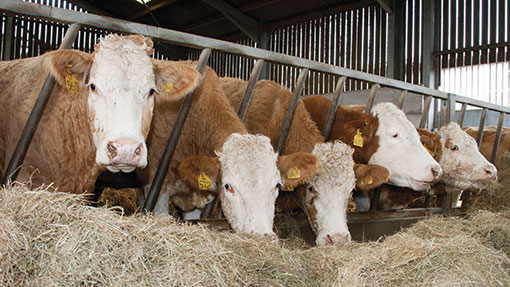Plan now for housing as the autumn weather breaks

Autumn arrived this week with the unsettled weather signalling the need for beef farmers to start planning ahead for winter housing.
But with a high number of lungworm cases being reported, as a result of the recent warm, wet weather, farmers are being urged to treat suspected cases now rather than wait until housing.
Oli Hodgkinson from Trefaldwyn Vets, Montgomeryshire, says six lungworm cases have been confirmed on his clients’ farms and he puts the higher number down to the wet, mild conditions.
See also: Buying vaccinated calves crucial for hitting winter growth targets
He warns farmers should not wait until housing if they have noticed clinical signs of infection in animals.
“If you are noticing cows coughing and you are not due to house them, then treat as soon as possible,” says Mr Hodgkinson.
If animals have got lungworm, Mr Hodgkinson says farmers should also consider vaccinating youngstock next spring.
“A lot of people have moved away from vaccination, but it is a real safety measure. It is more expensive than routine worming but we are going to end up with resistance if we continue to use pour-on.”
Lungworm vaccination should be undertaken before turnout and requires two injections, administered four weeks apart, says Mr Hodgkinson.
Housing cattle
Housing is the ideal time to treat cattle for parasitic diseases.
Mr Hodgkinson says dung sampling is the best way to ensure treatments are not being administered unnecessarily, especially as the weather has been dry this season.
Mr Hodgkinson advises taking a minimum of 10 samples. He adds: “You can ask your vet to do it during a TB test [to save another callout].”
Product choice must target the correct life stage of fluke, warns Mr Hodgkinson.
If farmers are treating cattle with broad-spectrum products containing the active ingredient triclabendazole, he says they should ideally worm two weeks post-housing to ensure immature flukes are killed.
But those using flukicides containing closantel or nitroxynil should wait five to six weeks after housing, otherwise a proportion of the immature fluke may survive the treatment.
Mr Hodgkinson says farmers should not blanket treat all cattle for worms.
“You don’t need to worm adult cows because they will have immunity,” he explains.
Instead the focus should be on dosing youngstock. If there is a known fluke problem, Mr Hodgkinson says combination products should be considered.
Minimising stress
Housing also signals the time for weaning. Westpoint vet Tim Potter says farmers should be aiming to minimise growth checks and maintain growth consistency of calves at housing.
Spring-born calves should be achieving in excess of 1kg/day daily liveweight gain, he adds.
Dr Potter explains how this can be achieved by minimising other stresses and potential issues for disease in the run-up to housing.
“Look at vaccinating against pneumonia prior to housing, it needs to go in before the risk period.”
The exact timing will vary depending on the vaccine used, says Dr Potter, but the vaccination programme needs to be completed about two weeks before housing.
Keeping cows and calves out as long as possible requires careful balancing. Housing is said by many to increase stress, create additional labour to maintain bedding and hygiene, and there is more risk of pneumonia, says Dr Potter.
However, leaving them out too long will compromise calf growth rates as the weather and cow body condition score deteriorates.
